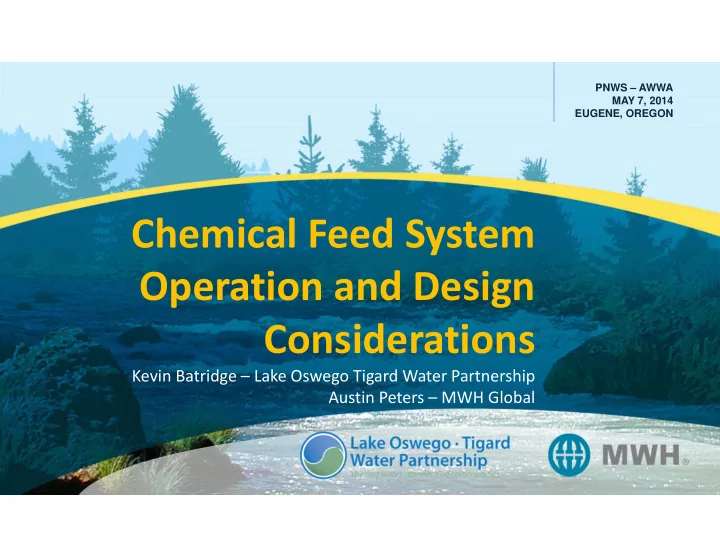

PNWS – AWWA MAY 7, 2014 EUGENE, OREGON Chemical Feed System Operation and Design Considerations Kevin Batridge – Lake Oswego Tigard Water Partnership Austin Peters – MWH Global
Chemical Delivery and Storage Chemical Delivery Agenda Bulk Storage Considerations Chemical Containment Dry Chemicals & Polymers Chemical Metering and Delivery Chemical Metering Pumps Chemical Feed Piping Feed Piping Leak Containment Chemical Feed Optimization Inventory Measurement Chemical Feed Control Strategies Dose Optimization
Delivery and Storage Pumps Instrumentation
Delivery and Storage Delivery and Storage Challenges Truck access Indoor vs. outdoor installation Acid and base general layout Tank materials Containment Tank Maintenance What are some other chemical delivery and storage challenges?
Delivery and Storage Bulk Tank Delivery Truck Routes Truck Site Access Commercial Vs. Residential environment Supplier Availability Their Specific Requirements Order Lead time What are some other chemical delivery and storage challenges?
Delivery Bulk Tank Delivery Continued Traffic patterns Covered truck pad Spill containment and management
Delivery Bulk Tank Delivery Offloading Bulk tank volumes Overfill protection Freeze protection Truck Sampling
Delivery Bulk Tank Delivery Safety Eyewashes and showers Tempered water Remote or local alarming Fire Code Requirements Lighting What PPE is required during chemical deliveries?
Delivery
Delivery
Storage Bulk Tank Location Indoor Vs. Outdoor Corrosion Insulation/ Temperature Control Appropriate Weather Cost
Storage Bulk Tank Material Material Compatibility & Longevity FRP, HDPE, LDPE, lined steel Indoor vs. Outdoor locations Capital and Maintenance Cost. Which materials have worked best in your experience?
Storage Bulk Tank Inspection & Maintenance Top or side entry Access catwalk Tank Replacement Containment Considerations
Storage Catwalk Access to Top of Tank Top Entry Manway No Side Entry Manways
Containment Chemical Containment Regulatory requirements Indoor vs. outdoor locations Fire Protection Containment for tanks and pumps Tank Replacement
Containment Chemical Containment Fire Code Oregon: Chapter 27 – Hazardous Materials Secondary containment required when vessel exceeds 55 gallons or aggregate capacity of multiple vessels exceeds 1,000 gallons
Containment Containment Volume Indoor Storage: Designed to contain a spill from the largest vessel plus the volume of fire sprinkler water for a period of 20 minutes. Outdoor Storage: Designed to contain a spill from the largest vessel plus the volume of a 24 ‐ hour rainfall from a 25 ‐ year storm.
Containment Containment Walls
Containment Sunken Containment
Containment Tote (IBC) Containment Containment Pallet Grated Containment Sump No Containment Which containment system do you prefer? Why?
Bulk Chemical Storage Other Considerations for Totes Handling and Storage Forklift access Loading dock Containment berms Inventory Control Manifold tote connections Weigh scales
Bulk Chemical Storage Dry Chemicals & Polymers Lifting Safety 50lb Bags Vs. Super Sacks Polymer Mixing Systems Dry Vs. Emulsion Vacuum assisted hopper
Ballasted Floc. Containment Sodium Polymer Hypochlorite Caustic Filter Aid Containment Soda Polymer Piping Sump Electrical Calcium Secondary Alum Room Thiosulfate Coagulant
Containment Pumps Located in Containment Area Sunken Containment with Stair Access Containments drain to individual exterior sumps Pipes in Trench to Avoid Trip Hazard
Other Storage Considerations Overhead Door Drive Through Access Corridor Overhead Door
Delivery and Storage Pumps Instrumentation
Pumps Pumping and Feeding Challenges Diaphragm Vs. Peristaltic Vs. Gear Pumps Integral pump controls Vs. External Local Control Station Pump Mounting in Relation to Tank Invert When to Use Carrier Water? Piping Containment What are some other chemical pumping and feeding challenges?
Pumps Chemical Metering Pumps Diaphragm or Peristaltic (Hose) or Gear Pumps? Pump Maintenance Which type of chemical pump do you prefer? Why?
Pumps Metering Pump Controls Integrated or centralized local control? Flow measurement / detection Pump Calibration
Pumps Pump Placement Position is important Not all pumps provide positive suction Raise the tanks or… Lower the pumps Spill control and safety Maintenance access Wash ‐ down and sump placement
Pumps Piping Flexibility Vs. Complexity Access to piping for maintenance Off ‐ gassing Sloped runs Eccentric reducers Vents at high points & Vented Valves
Pumps Piping Leak Containment Leak Containment Clear PVC Double or single wall Spill control and safety Maintenance impacts
Organized pipe/instrument rack Pumps located on a Uncontained shelf for easy access, piping transitions but close to bottom of to contained tank elevation for tubing between flooded suction buildings
Delivery and Storage Pumps Instrumentation
Instrumentation Chemical Feed Control Tools for inventory management Analyzers and Control Elements Programming and Automation Process Control for efficient chemical use What are some other tools to optimize chemical use?
Instrumentation Inventory Measurement Bulk tank level tracking Sight glass Vs Reverse Float Level Ultrasonic, radar, pressure Chemical Flow metering Mini ‐ mag flow metering Thermal dispersion switch
Instrumentation Chemical Feed Control Strategies Controlling Feedback Loops SCADA Minimize lag time Position analyzer Process Stream element close to sample source Raw Water Sample Flow Meter Carrier Flow metering / Water Chemical Feed monitoring Mag ‐ Meter Flow pacing Vs. Residual Chlorine Manual dose control Analyzer Hypochlorite Streaming current Feed
Instrumentation Inventory & Dose Control Inventory monitoring Dose Calibration Performance Monitoring Performance Optimization
Last Impressions Chemical Systems are the Heart of the Treatment Process There are lots of important things to consider in Chemical System Design, including: Safety Reliability Operability What are the most important No one size fits all components of a chemical system?
Kevin Batridge - kbatridge@ci.oswego.or.us Austin Peters - austin.peters@mwhglobal.com
Recommend
More recommend